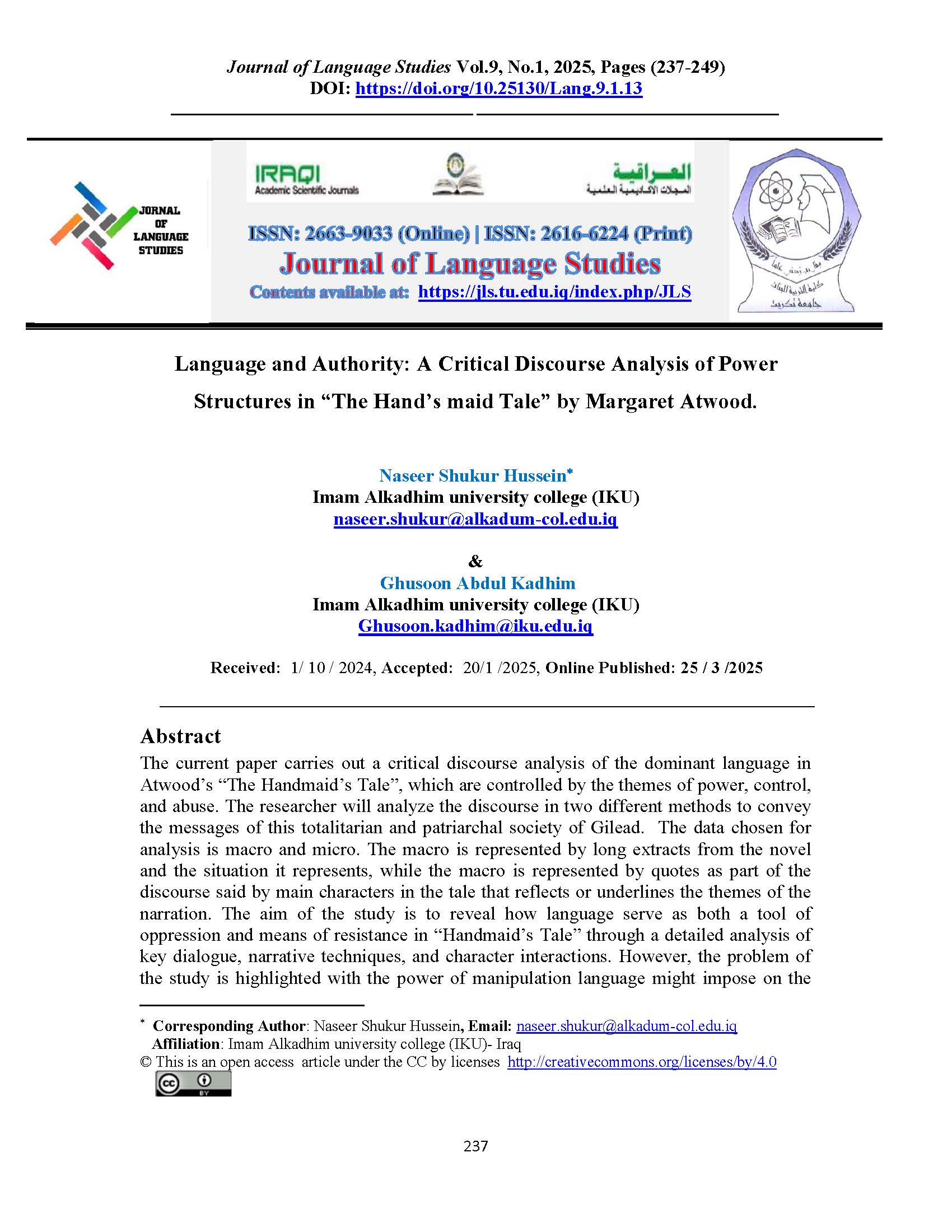Language and Authority: A Critical Discourse Analysis of Power Structures in “The Hand’s maid Tale” by Margaret Atwood
DOI:
https://doi.org/10.25130/Lang.9.1.13Keywords:
authority, resilience, CDA, women, social norms, patriarchyAbstract
The current paper carries out a critical discourse analysis of the dominant language in Atwood’s “The Handmaid’s Tale”, which are controlled by the themes of power, control, and abuse. The researcher will analyze the discourse in two different methods to convey the messages of this totalitarian and patriarchal society of Gilead. The data chosen for analysis is macro and micro. The macro is represented by long extracts from the novel and the situation it represents, while the macro is represented by quotes as part of the discourse said by main characters in the tale that reflects or underlines the themes of the narration. The aim of the study is to reveal how language serve as both a tool of oppression and means of resistance in “Handmaid’s Tale” through a detailed analysis of key dialogue, narrative techniques, and character interactions. However, the problem of the study is highlighted with the power of manipulation language might impose on the mass. This is evident in the findings underscore the significant linguistic strategies in shaping collective identities and resilience in fictional world and contemporary society.
References
Anita, D. (2023). Margaret Atwood as a Feminist. International Journal for Science Technology And Engineering, 11(10), 1912–1915. https://doi.org/10.22214/ijraset.2023.56336.
Atwood, M. (1986). The Handmaid's Tale. New York: Random House.
Bezar, S. A., Iqbal, A., Noreen, M., Asif, M., & Azhar, M. A. (2023). Fairclough’s three dimensional model: critical discourse analysis of Blake’s “The Sick Rose” and Rashid’s “Mery Bhi Hai Kuch Khaab”. Journal of Positive School Psychology (ISSN: 2717-7564), 7(2), 223-232.
Bouson, J. B. (2018). The Handmaid's Tale: A Critical Study. New York: Routledge.
Crenshaw, Kimberlé. (1989). Demarginalizing the Intersection of Race and Sex: A Black Feminist Critique of Antidiscrimination Doctrine, Feminist Theory and Antiracist Politics. Chicago. University of Chicago Legal Forum.
Duffy, M. (2020). Margaret Atwood on what ‘The Handmaid’s Tale’ means in the age of Trump. The Guardian. Retrieved from https://www.theguardian.com/books/2020/mar/12/margaret-atwood-handmaids-tale-age-of-trump
Fairclough, N. (2013). Critical discourse analysis. In The Routledge handbook of discourse analysis (pp. 9-20). Routledge.
Ghosh, A. (2021). Dystopian literature and its real-world parallels: A study of “The Handmaid's Tale”. Journal of Dystopian Studies, 5(2), 45-60.
Heller, A. (2022). Feminism and totalitarianism in Atwood's work. Feminist Literary Studies, 28(1), 15-30.
Johnson, L. (2020). The cultural impact of “The Handmaid's Tale”. Cultural Studies Review, 26(3), 78-92.
Kang, J., & Duan, C. (2023). Animal representations in Margaret Atwood’s novels: a study based on pan-indexicality model. https://doi.org/10.1515/lass-2023-0026.
Naydenova, R. R. (2024). Mythological heroes, historical figures and characters of world literature in the works of Margaret Atwood. Filologiâ: Naučnye Issledovaniâ. https://doi.org/10.7256/2454-0749.2024.3.70207.
Nešić, M., & Kaličanin, M. (2023). The Katabasis Trope and a Descent into Future in Margaret Atwood’s The Handmaid’s Tale. https://doi.org/10.51558/2490-3647.2023.8.3.279
Omarova, P. M., & Dzhigerova, M. E. (2024). The Structure of the Concept handmaid in M. Atwood’s “The Handmaid’s Tale.” Вестник Дагестанского Государственного Университета. https://doi.org/10.21779/2542-0313-2024-39-2-71-77
Reynolds, L. M. (2024). Discussion on the Relationship Between Religion and Gender Oppression in The Handmaid’s Tale. Studies in Social Science & Humanities, 3(6), 1–7. https://doi.org/10.56397/sssh.2024.06.01.
Schäffer, A. (2024). Tulajdonnév vagy a tulajdon neve? Névtani Értesítő, 46, 99–116. https://doi.org/10.29178/nevtert.2024.8
Smith, J. (2019). The Handmaid's Tale: A graphic novel. New York: Penguin Random House.
Thompson, R. (2021). The politics of gender in The Handmaid's Tale. Journal of Gender Studies, 30(4), 345-360.
Turki, H. I., & Abdulrazzaq, D. M. (2023). A Marxist Reading of Margaret Atwood’s the Handmaid’s Tale. Al-Adab Journal. https://doi.org/10.31973/aj.v1i146.3726
Williams, K. (2022). Things in “The Handmaid's Tale” based on real-life history. Historical Contexts in Literature, 12(1), 22-35.
Wodak, R. (2014). Critical discourse analysis. In The Routledge companion to English studies (pp. 302-316). Routledge.

